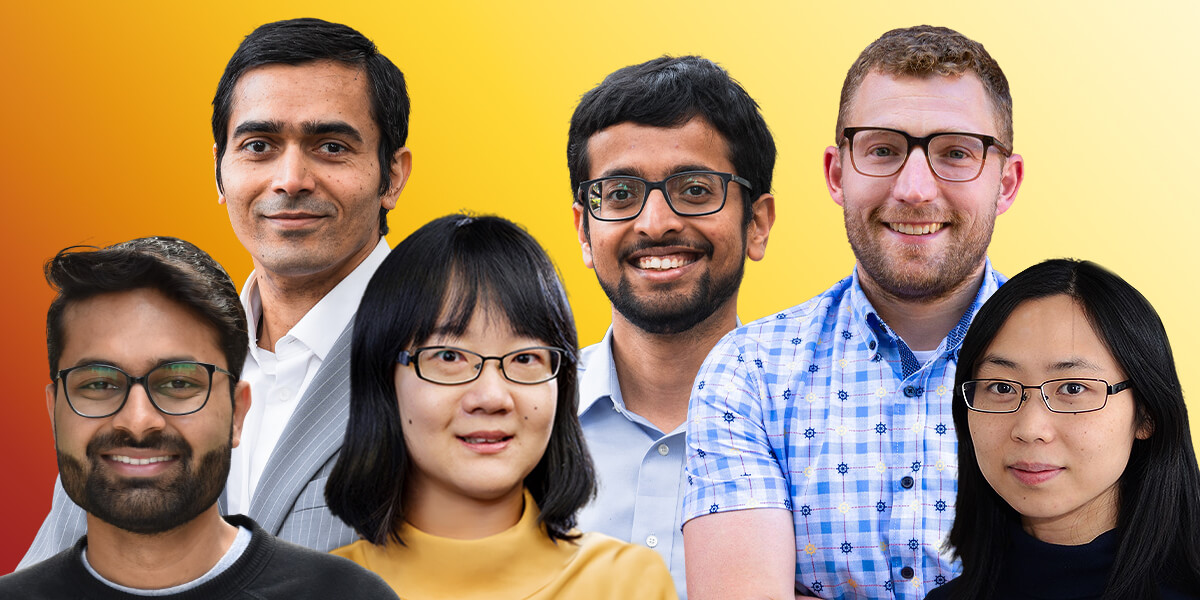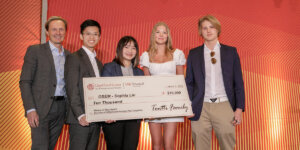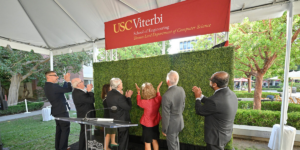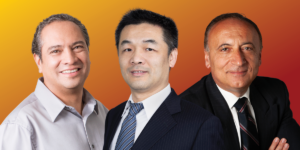
2023 NSF CAREER Award Winners Feifei Qian, WiSE Gabilan Assistant Professor of Electrical and Computer Engineering and Aerospace and Mechanical Engineering; Birendra Jha, assistant professor in the Mork Family Department of Chemical Engineering and Materials Science; Paul Plucinsky, assistant professor of Aerospace and Mechanical Engineering; Sze-Chuan Suen, WiSE Gabilan Assistant Professor of Industrial and Systems Engineering; Somil Bansal, assistant professor of electrical and computer engineering and computer science; and Vatsal Shara, assistant professor in the Thomas Lord Department of Computer Science.
Six USC Viterbi School of Engineering assistant professors have been recognized with the prestigious National Science Foundation (NSF) CAREER Award for 2023. The award honors early-career faculty members with the potential to serve as academic role models in research and education to lead advances in their respective fields. The NSF selects CAREER Award recipients who are building a firm foundation for a lifetime of leadership in integrating education and research.
Over the last two years, 14 NSF CAREER Awards have been given to USC Viterbi faculty members. This year’s winners are Sze-Chuan Suen, WiSE Gabilan Assistant Professor of Industrial and Systems Engineering; Birendra Jha, assistant professor in the Mork Family Department of Chemical Engineering and Materials Science; Vatsal Shara, assistant professor in the Thomas Lord Department of Computer Science; Feifei Qian, WiSE Gabilan Assistant Professor of Electrical and Computer Engineering and Aerospace and Mechanical Engineering; Somil Bansal, assistant professor of electrical and computer engineering and computer science; and Paul Plucinsky, assistant professor of Aerospace and Mechanical Engineering.
Sze-Chuan Suen
Working within the Daniel J. Epstein Department of Industrial and Systems Engineering, Suen focuses on developing mathematical, economic and applied operations research approaches to guide health policy decisions and control and manage infectious diseases.
She has worked on research to control tuberculosis outbreaks and address drug resistance, as well as recent work to harness traffic data to understand how diseases spread.
Suen’s NSF CAREER Award proposal is titled “Advancing Disease Modeling for Decision Making in Healthcare.” The work aims to improve infectious disease modeling by capturing the differences and diversity among individuals within a population and developing insights into how this could improve health policy and decision-making.
Suen said she was delighted and surprised to receive an NSF CAREER Award. She said the behavior of subgroups in a population can influence disease dynamics — as the COVID pandemic demonstrated — making it a critical factor in developing effective disease control policy.
“The key goals of the work are to further develop infectious disease models to better incorporate individual-level heterogeneity for population models to help better allocate health resources for epidemics,” Suen said. “This funding will greatly facilitate my future work on several disease models, as well as support students who are passionate about this area.”
The project will partner with policymakers including the L.A. Department of Public Health to generate actionable public health policy for broader societal impacts. The research will also be harnessed to improve education for students and professional collaborators, such as health providers and policymakers.
Suen’s project will also bring together interdisciplinary teams of students and medical practitioners to consult on, design and implement the proposed research initiatives. The research will be integrated into a project-oriented course allowing students to work on real-world problems identified by clinicians and policymakers.
Birendra Jha
Jha is a geoscientist in the Mork Family Department of Chemical Engineering and Materials Science. His research focuses on modeling groundwater flows, contaminant transport, induced seismicity, hydraulic fracturing, subsurface characterization and more.
Jha’s NSF CAREER Award project, titled “Solute Transport Coupled to Geomechanics and Convective Mixing,” will focus on understanding how fluid travels through fractured rocks — also known as fractured aquifers. The funding will enable Jha to recruit and train graduate and undergraduate students to conduct novel experiments and modeling studies to better understand how groundwater contaminants are diluted as they move through rocks.
The project’s second goal is to develop research-based simulation tools that address the needs of groundwater engineers and hydrogeologists, who often struggle to predict how contaminants travel through fractured rock. The research will also offer vital background to aid remediation efforts for contamination in aquifers.
Jha was surprised and happy at the news of his CAREER Award, which he said was a culmination of three years of dedicated work on the proposal, with multiple iterations.
“Understanding the movement and dilution of fluids in fractured aquifers is important for the safe disposal and effective containment of industrial wastes such as greenhouse gases and radioactive wastes,” Jha said. “Current methods to predict the position and shape of the moving plume of fluid in the rock suffer from our lack of knowledge about the interaction between fluid and rock containing the fractures. This often leads to poor selection of the waste disposal site and errors in the forecast of plume position and size, which manifests as an increase in the aquifer remediation cost and pollution hazard.”
Jha said his project will generate datasets and modeling tools, which will be shared with groundwater engineers, hydrogeologists and environmental engineers via an industry-academia partnership.
Vatsal Sharan
Vatsal Sharan is an assistant professor of computer science where he works on the foundations of machine learning, specifically the intersection of machine learning, theoretical computer science and statistics. His research aims to understand fundamental limits for solving learning and estimation tasks given computational and information theoretic constraints, and to use this understanding to develop practical algorithms which are efficient, fair and robust.
Sharan’s NSF CAREER Award project titled “Computational Foundations of Modern Machine Learning” aims to re-examine some of the foundations of learning theory and develop a theory that takes into account modern requirements such as memory efficiency and robustness. It addresses the significant gaps in the theoretical understanding of some of the most foundational aspects which are crucial for applications in various areas of society, including healthcare, transportation, education and commerce.
In doing this, the project will help build a rich algorithmic suite and significantly increase the scope of current applications and develop insights that can guide the understanding of new theoretical angles on learning and computation.
“For a technology which is poised to be as revolutionary as machine learning, it is rather surprising how little we understand about the fundamental principles which govern it,” said Sharan.“Not only is this unsatisfying from a scientific standpoint, it often leads to current approaches being unable to meet the constraints which today’s applications demand. This proposal aims to address this by building a rich theory of modern ML which takes into account modern computational and statistical considerations, such as memory constraints and robustness.”
An educational plan is tightly integrated with the research objectives of the project, including outreach activities with high-school students and a collaboration with the Los Angeles County Office of Education.
Feifei Qian
Working within the Ming Hsieh Department of Electrical and Computer Engineering, Qian analyzes and models the complex interactions between robots and their locomotion environments and generates innovative control and sensing strategies to improve robot mobility on challenging terrains. She is interested in creating robots that can achieve agile movement like animals — such as lizards, snakes and insects — who adjust their movement strategies to the surfaces they encounter. Her previous work has uncovered bio-inspired principles of foot design and ground-contact strategies for robots to achieve high mobility on a variety of ground conditions, including soft sand and bumpy terrain.
Qian’s NSF CAREER Award proposal is titled “Utilizing Physical Interactions to Improve Legged Mobility on Challenging Terrains.” Unlike most existing mobility approaches that require robots to avoid obstacles and collisions, this research aims to develop parkour-like strategies that allow robots to actively utilize interactions or even collisions with their environments to produce life-like movement. These new locomotion strategies can empower legged robots for a broad range of real-world missions, such as search and rescue, delivery and Earth and planetary explorations.
In addition, this project will translate part of the robotic mobility research into hands-on education activities across classroom, laboratory and real-world environments, to inspire and train the next generation of roboticists.
“Receiving this award is an amazing opportunity for me to establish an initial version of my vision — for robots to embrace and utilize physical interactions with the environments to move around,” said Qian. “By developing and demonstrating improved locomotion and sensing capabilities of legged robots to robustly operate in natural, complex environments, I hope that legged robots could move beyond laboratory settings and begin to aid people in a variety of daily tasks.”
Somil Bansal
Bansal’s work focuses on trying to get autonomous robots to perform their work more efficiently, while also improving their safety as they navigate unfamiliar spaces and interact with humans.
He spent a year as a research scientist at Waymo (formerly known as the Google Self-Driving Car project) in Mountain View. He now leads the Safe and Intelligent Autonomy Lab at the Ming Hsieh Department of Electrical and Computer Engineering, where he and his colleagues design various robotics and systems (including wheeled robots and drones) that use sensors, cameras and other “perception components” to help them make intelligent choices out in the world.
“These robots are going to go around in unpredictable environments and leverage data and AI for making decisions,” Bansal says. “How do we make sure they do that safely?”
Bansal’s NSF CAREER Award proposal is titled “Safety Assurances for Perception-Enabled Robotic Systems.” Perception failures “can cascade to catastrophic robot failures and compromise human safety, as exemplified by recent self-driving car accidents,” Bansal wrote in his proposal’s abstract. “Therefore, ensuring safe robot operation under learning-driven, perception-based controllers is paramount to enable their adoption in high-integrity and safety-critical applications.”
“The ability to develop safe perception-driven systems will have a direct, positive impact on a broad range of robotics applications where safety and reliability are of high importance, such as surveillance of critical infrastructure, service or delivery robots and autonomous cars.”
Paul Plucinsky
Working within the USC Department of Aerospace and Mechanical Engineering, Paul Plucinsky develops theories that capture how and why materials work, generating predictions relevant to the design of new materials, structures and devices.
His work has a uniquely visual quality – such as his investigation of origami and kirigami techniques to predict how new metamaterials behave. Other topics explored with his research group have included nematic elastomer sheets, shape-memory alloys and phase transitions in nano-structures.
Plucinsky’s NSF CAREER Award project is titled “Effective continuum modeling of mechanism-based metamaterials.”
Mechanism-based metamaterials are cell-based patterns of stiff panels, connected at flexible hinges or folds, designed to achieve large overall shape-change at little overall stress. They are promising materials for many applications, including for locomotion in soft robotics and for deployment of medical devices and satellites. However, their mechanical behavior arises from a multiscale coupling spanning collective cell-wise interactions, large panel rotations, and localized distortion at the hinges or folds that is challenging to model.
Through analysis of the fundamentals, Plucinsky’s study aims to develop predictive models capable of efficiently navigating the design space of these materials and predicting their response under a broad range of loads and stimuli. These models will allow engineers to easily adjust materials to attain a desired property, removing the need for prolonged investigation or excessive simulations.
“Based on the analysis we’re doing, we can potentially design new systems that haven’t been considered yet,” said Plucinsky. ““I want to work on problems that are at the forefront of theory in solid mechanics, and I want to do them in a way that is as systematic and rigorous as possible. There’s a fascinating confluence of manufacturing and material science that enables creating these types of patterns in a systematic and easy way.”
Education and outreach is also an important part of the project, including research opportunities for undergraduate students from Cal State LA, a minority serving regional university, and for local high school students.
Published on July 25th, 2023
Last updated on November 27th, 2024











